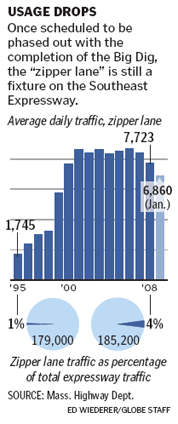Before dawn and dusk every weekday, the large, lumbering machines crawl along the Southeast Expressway, gobbling 750-pound concrete barriers at one end and spitting them out in seamless rows at the other.
The heavy lifting required to open and close the so-called zipper lanes on the 6 mil
 es of Interstate 93 south of Boston has become increasingly expensive as the Pac-Man-like trucks get older and a dwindling number of vehicles use the high-occupancy lanes.
es of Interstate 93 south of Boston has become increasingly expensive as the Pac-Man-like trucks get older and a dwindling number of vehicles use the high-occupancy lanes.On an average day in January, fewer than 7,000 vehicles - cars with two or more occupants, motorcycles, and emergency vehicles - used the zipper lanes, a 20 percent drop from the average peak use three years ago.
The 14-year-old barrier transport vehicles are well beyond their intended lifespan and will have to be replaced in the next few years at a cost of more than $1 million apiece.
As lawmakers debate how to pay for the deteriorating transportation system, the high replacement cost raises questions about whether the state should continue an operation that already costs taxpayers $1.25 million a year.
Last week, the Massachusetts Taxpayers Foundation encouraged state officials to join a federal program to convert the high-occupancy vehicle, or HOV, lanes on I-93 into high-occupancy toll, or HOT, lanes.
The idea would be to allow single-occupancy vehicles to pay a toll to use the zipper lanes. Carpoolers would still drive for free, but solo drivers would pay to use the lanes with transponders.




